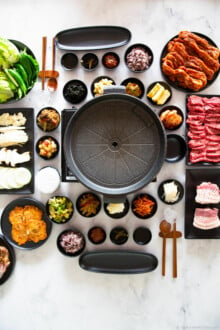Jjimdak is a popular Korean braised chicken. It originated in the city of Andong, Korea. It’s savoury, mildly salty and sweet with a very subtle spicy kick. It has a somewhat complex flavour and because of that, it’s highly addictive and comforting!
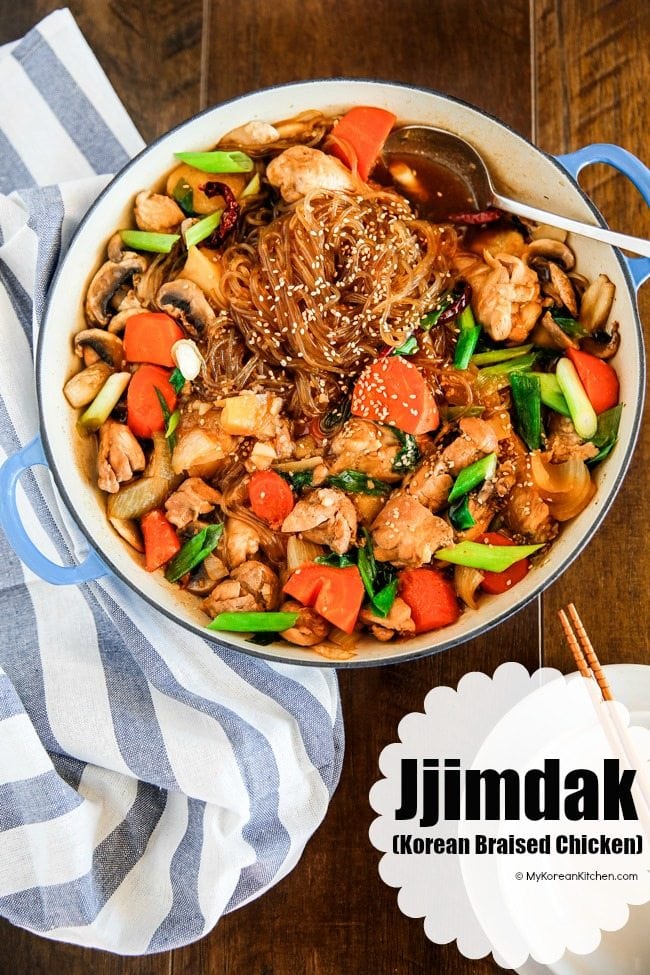
Jjimdak (찜닭, Korean braised chicken) recipe has been on my to-do list for a long time, since 2013, so I’m super excited to share it with you today!
This recipe is even more special in that it is developed by my sister! My involvement has been testing the recipe and writing more refined instructions of it.
The thing is I’ve never had Jjimdak in Korea before, but my sister had, so it was logical to involve her in the recipe development.
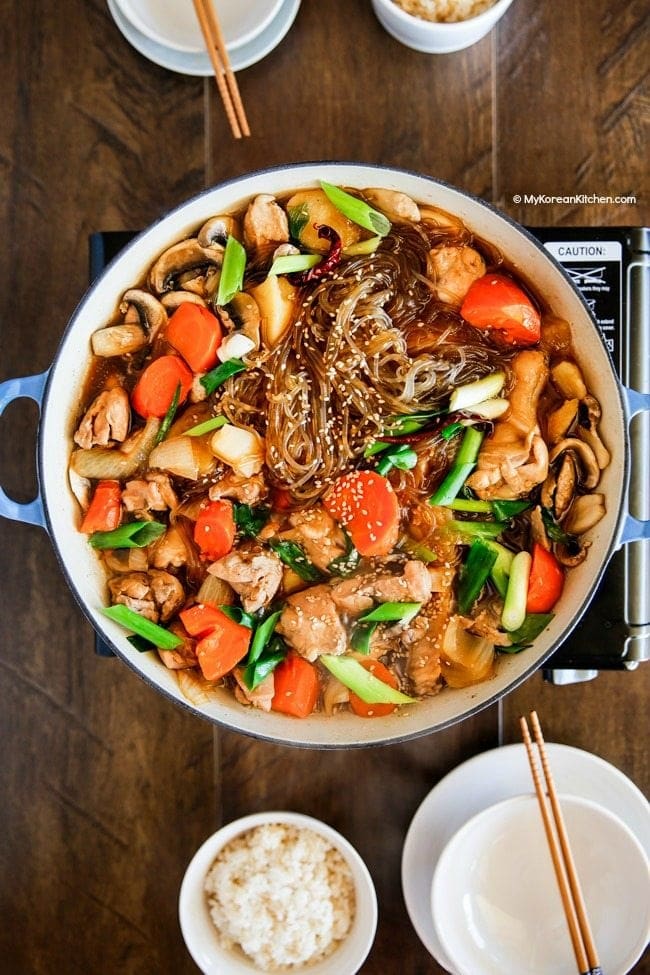
We even visited our local Korean restaurant here that is well known for Jjimdak. It was good, but it tasted a bit artificial. Maybe they added caramel sauce or oyster sauce too much to make the dish look darker and look more appetising. Whatever it was, we couldn’t eat too much of it. We’ve yet to discover a good Jjimdak restaurant here!
On the contrary, you can eat our Jjimdak over and over. OK, I might be biassed, but my daughter absolutely adores this Jjimdak! It is the only dish lately that she asks for a second serving! (I struggle every day to make her eat with all the other food, but this one is exception!)
I don’t know the restaurant’s secret’s sauce, but our Jjimdak is braised in soy sauce and honey infused sauce. Of course, the usual Korean essential spices, garlic and ginger are added too.
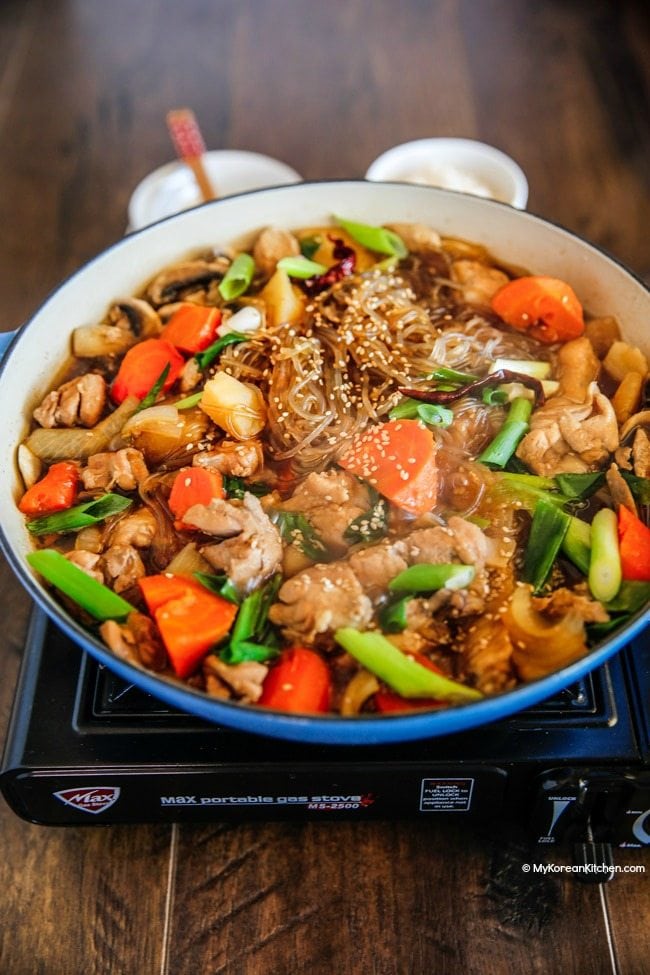
It has a slightly salty and sweet flavour, but it gives a mild spice kick to your taste buds as well because there are some dried chillies too. While dried chillies can be omitted or added more per your liking, they certainly make the flavour more complex, in a good way. So I highly recommend you adding it at least as much as we did. 😉
In my opinion, the best part about Jjimdak is you don’t need additional side dishes or soup to serve with it. All you need is a bowl of hot steamed rice! There’s enough sauce so you can mix your rice with it. I also love the braised potatoes and glass noodles in it. They make the best side dishes! Yummo!
I hope you try our recipe soon! Enjoy!
P.S. There is also a spicy version of Korean braised chicken. It’s called Dakdoritang (닭도리탕) or Dakbokkeumtang (닭볶음탕). And I have a slow cooker version if you would like to try it out! Check my Slow Cooker Korean Spicy Braised Chicken and Potatoes.
Ingredients for 4 servings
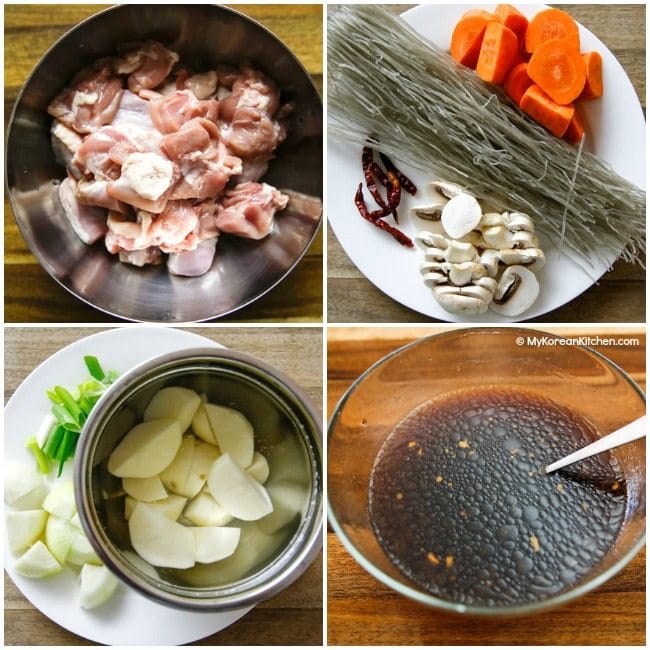
Main
- 800g/1.8 pounds chicken (I used a mix of chicken drumettes & wingettes and thigh fillets), cut into medium sized chunks
- 5 cups water to parboil the chicken
- 2 medium potatoes (340g/12 ounces), cut into medium sized chunks
- 1 medium carrot (170g/6 ounces), cut into medium sized chunks
- 1 large brown onion (210g/7.4 ounces), cut into medium sized chunks
- 5 dried small red chillies (2g/0.07 ounces) (I used Thai chillies, but you can use Korean chillies if you can get them)
- 150g/5.3 ounces Korean glass noodles, soaked in warm water for about 20 mins to hydrate, drain before use
- 3 button mushrooms or shiitake mushrooms (80g/2.8 ounces), thinly sliced
- 1 stalk of green onion (20g/0.7 ounces), diagonally chopped
- 1 tsp roasted sesame seeds
Sauce (Mix these in a bowl)
- 1 & 1/2 cup water
- 1/3 cup soy sauce
- 2 Tbsp raw sugar or dark brown sugar
- 2 Tbsp rice wine/mirin
- 1 Tbsp honey
- 1 Tbsp msg free oyster sauce
- 1 Tbsp minced garlic
- 1/2 tsp minced ginger
- 2 tsp sesame oil
- 1/4 tsp ground black pepper
* 1 Tbsp = 15 ml, 1 Cup = 250 ml
**If you want to learn more about Korean cooking ingredients, check my 30 essential Korean cooking ingredients list!
How to Make Jjimdak
1.On medium-high heat, boil the water (5 cups) in a medium sized pot. Once it’s rolling boiling, parboil the chicken for 1 minute to skim off any fat. Drain the water.
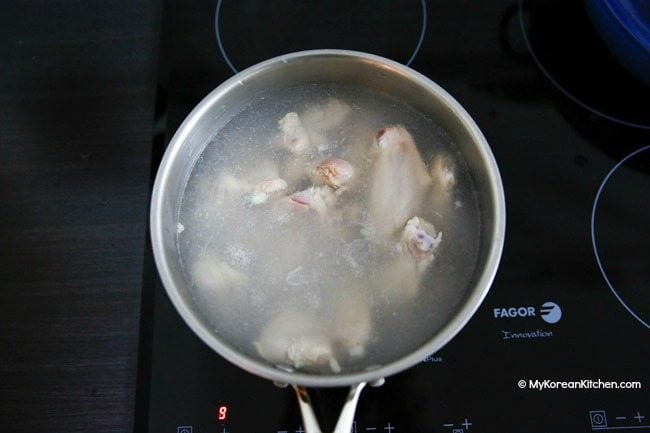
2. In a clean pot (I used this braising pot), add the chicken and the sauce. Boil them over medium-high heat for about 10 mins, covered.
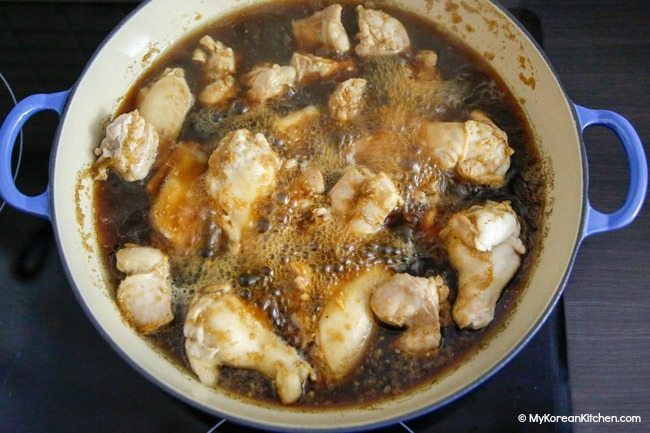
3. Add the potatoes, carrots, onions and chillies and boil for a further 7 mins, covered. Reduce the heat to medium and stir gently to change the position of the chicken and the vegetables. Simmer for a further 8 mins, covered.
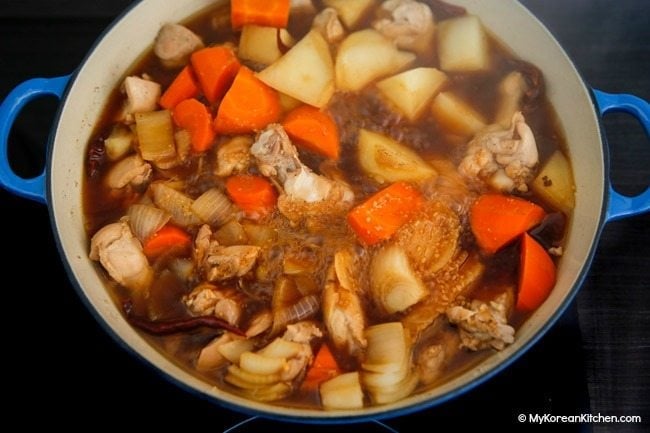
4. Add the glass noodles, mushrooms, and green onions and simmer until the noodles and mushrooms are cooked (about 3 to 5 mins), covered. Stir lightly to make sure the noodles and the mushrooms are mixed with the sauce.
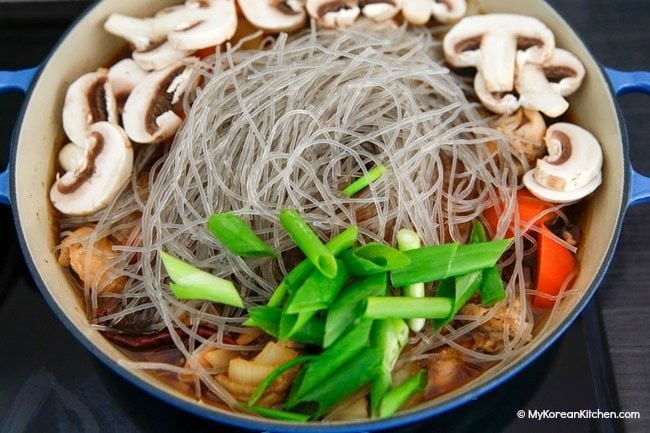
5. Garnish with the sesame seeds. (You can add additional green onions for extra poppy colour before serving as well.) Serve hot with a bowl of steamed rice.
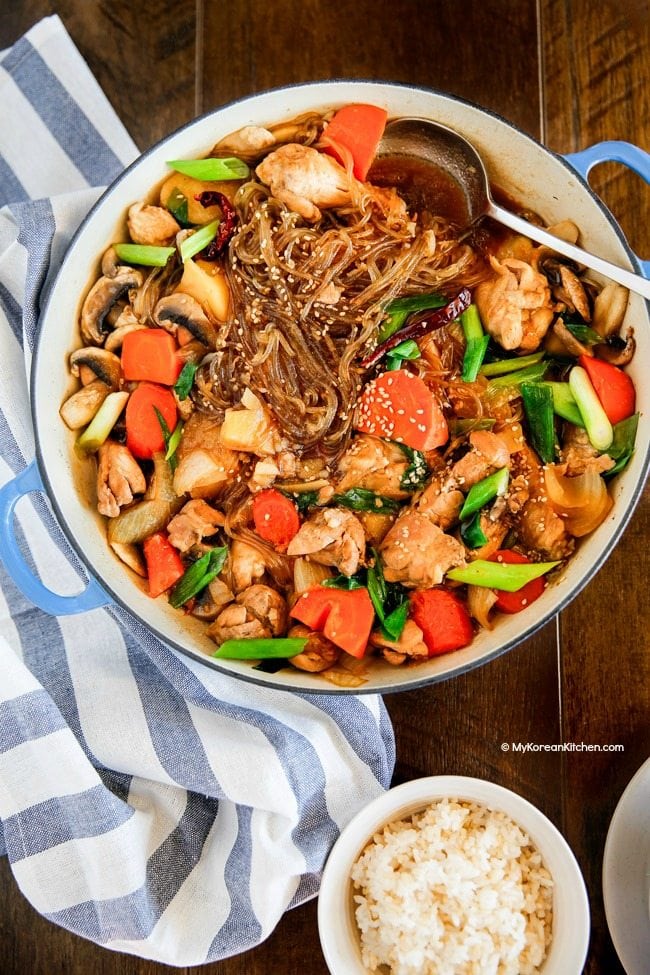

Jjimdak (Korean Braised Chicken)
Ingredients
MAIN
- 800 g chicken (1.8 pounds), cut into medium sized chunks, I used a mix of chicken drumettes & wingettes and thigh fillets
- 5 cups water to parboil the chicken
- 2 medium potatoes (340 g / 12 ounces) cut into medium sized chunks
- 1 medium carrot (170 g / 6 ounces), cut into medium sized chunks
- 1 large brown onion (210 g / 7.4 ounces), cut into medium sized chunks
- 5 dried small red chillies (2 g / 0.07 ounces), I used Thai chillies but you can use Korean chillies if you can get them
- 150 g Korean glass noodles (5.3 ounces), soaked in warm water for about 20 mins to hydrate, drain before use
- 3 button mushrooms or shiitake mushrooms (80 g / 2.8 ounces), thinly sliced,
- 1 stalk of green onion (20 g / 0.7 ounces), diagonally chopped,
- 1 tsp toasted sesame seeds
SAUCE (MIX THESE IN A BOWL)
- 1 1/2 cup water
- 1/3 cup soy sauce
- 2 Tbsp raw sugar or dark brown sugar
- 2 Tbsp rice wine/mirin
- 1 Tbsp honey
- 1 Tbsp msg free oyster sauce
- 1 Tbsp minced garlic
- 1/2 tsp minced ginger
- 2 tsp sesame oil
- 1/4 tsp ground black pepper
Instructions
- On medium-high heat, boil the water (5 cups) in a medium sized pot. Once it’s rolling boiling, parboil the chicken for 1 minute to skim off any fat. Drain the water.
- In a clean pot (I used this braising pot), add the chicken and the sauce. Boil them over medium-high heat for about 10 mins, covered.
- Add the potatoes, carrots, onions and chillies and boil for a further 7 mins, covered. Reduce the heat to medium and stir gently to change the position of the chicken and the vegetables. Simmer for a further 8 mins, covered.
- Add the glass noodles, mushrooms, and green onions and simmer until the noodles and mushrooms are cooked (about 3 to 5 mins), covered. Stir lightly to make sure the noodles and the mushrooms are mixed with the sauce.
- Garnish with the sesame seeds. (You can add additional green onions for extra poppy colour before serving as well.) Serve hot with a bowl of steamed rice.
Notes
Nutrition Info (per serving)
The nutrition information shown is an estimate provided by an online nutrition calculator. It should not be considered a substitute for a professional nutritionist’s advice.
